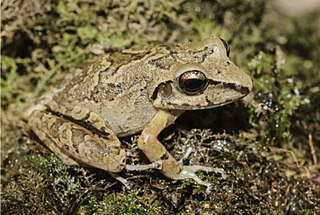
The white-faced spiny tree-rat is a spiny rat species from South America. It is found in Brazil, French Guiana, Guyana and Suriname.

Rhinella jimi is a species of toads in the family Bufonidae. It is endemic to northeastern Brazil and known between Bujaru in northeastern Pará and Maranhão in the north, south to Bahia and Vitória, Espírito Santo. Prior to its description in 2002, it was confused with Rhinella schneideri. The specific name jimi honors Jorge Jim, a Brazilian herpetologist. Common name Jimi's toad has been coined for it.

Rhinella scitula is a species of toads in the family Bufonidae. It is found in the southwestern Mato Grosso do Sul, Brazil, and in the adjacent southeastern Paraguay.
Oreophrynella weiassipuensis is a species of toads in the family Bufonidae. It is only known from Wei-Assipu-tepui, a tepui on the border between Brazil and Guyana. The holotype was collected in 2000 by a speleological expedition to Wei-Assipu-tepui. No other specimens are known. It is possible that it is present in other localities, but most species of Oreophrynella are endemic to a single mountain.
Teratohyla adenocheira is a species of frogs in the family Centrolenidae. It is known from the Noel Kempff Mercado National Park, its type locality in eastern Bolivia, as well as more widely from Brazil, in the states of Mato Grosso, Pará, and Rondônia. The species' closest relative is T. Midas.
Anomaloglossus tamacuarensis is a species of frog in the family Aromobatidae. It is found in the Sierra Tapirapecó in the Amazonas state of Venezuela as well as in the adjacent Amazonas state of Brazil.
Dendropsophus meridianus is a species of frog in the family Hylidae. It is endemic to southeastern Brazil.
Scinax exiguus is a species of frog in the family Hylidae. It is found in the Gran Sabana of Venezuela and in the Roraima state of the adjacent northern Brazil, as far south as Boa Vista, Roraima. Common name Gran Sabana snouted treefrog has been coined for it.
Ceuthomantis cavernibardus is a species of frog in the family Craugastoridae. It is found in the Sierra Tapirapecó in the Amazonas state of Venezuela as well as in the adjacent Amazonas state of Brazil. The specific name cavernibardus is derived from the Latin caverna for "cave" and bardus for "singer". It refers to the caves commonly used by calling males.
Ischnocnema sambaqui is a species of frogs in the family Brachycephalidae. It is endemic to the state of Paraná, Brazil, and known from the municipalities of Guaraqueçaba, Piraquara, and Morretes.
Pristimantis variabilis is a species of frog in the family Strabomantidae. It is found in the lowland Amazon rainforest and Andean slopes in southern Colombia, eastern Ecuador, eastern Peru, and western Brazil. The specific name variabilis refers to the variable dorsal coloration of this frog. Common name variable robber frog has been proposed for it.

Pristimantis vilarsi, also known as the Rio Uaupes robber frog, is a species of frog in the family Strabomantidae. It is found in the upper Amazon basin in Brazil, Peru, Colombia, and Venezuela.
Hamptophryne alios is a species of frog in the family Microhylidae. It is known from three localities in the southwestern Amazon Basin of Bolivia, Brazil, and Peru. This species used to constitute the monotypic genus Altigius, but molecular phylogenetic analyses have shown it to be close relative of the then-monotypic Hamptophryne, and the two genera have been merged.
Otophryne steyermarki is a species of frog in the family Microhylidae. It is found in western Guyana and in the Bolívar state in eastern Venezuela.

Pseudoeurycea aurantia, commonly known as Peña Verde salamander, is a species of salamander in the family Plethodontidae. It is endemic to Oaxaca, Mexico and only known from its type locality near Peña Verde, which is the northernmost high peak in the Sierra de Juárez.
The dark spiny tree-rat is a species of rodent in the family Echimyidae. It is a rarely encountered and nocturnal species, found in eastern Ecuador and central Peru.

The moss-forest blossom bat is a species of megabat in the family Pteropodidae found in New Guinea. Its natural habitat is subtropical and tropical dry forests.
Boana nympha is a species of frog in the family Hylidae. It is endemic to the upper Amazon basin of southern Colombia, eastern Ecuador, and northeastern Peru; its range probably extends into adjacent western Brazil. The specific name nympha alludes to nymphs, beautiful wood- and marsh-dwelling goddesses in Greek mythology. Common name nympha Amazon treefrog has been proposed for it.

Vieira's titi monkey is a species of titi, a type of New World monkey, from central-northern Brazil.

The Alta Floresta titi monkey, also known as the Groves' titi monkey, is a species of titi monkey, a type of New World monkey, endemic to Brazil. It was described from the municipality of Alta Floresta in the state of Mato Grosso.








